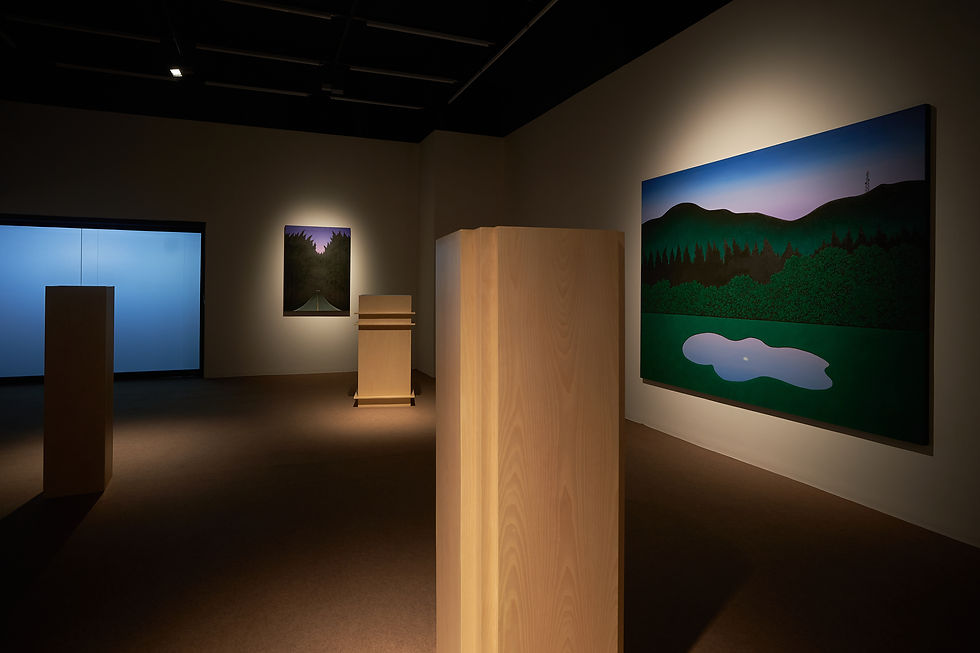
"A House without A Roof", Nova Contemporary, Bangkok, Thailand, 2024 Photo: Krittawat Atthsis

"A House without A Roof", Nova Contemporary, Bangkok, Thailand, 2024 Photo: Krittawat Atthsis

"A House without A Roof", Nova Contemporary, Bangkok, Thailand, 2024 Photo: Krittawat Atthsis

"A House without A Roof", Nova Contemporary, Bangkok, Thailand, 2024 Photo: Krittawat Atthsis
A HOUSE WITHOUT A ROOF
A duo exhibition by Jedsada Tangtrakulwong and Vacharanont Sinvaravatn
3 February - 14 March 2024
Nova Contemporary, Bangkok, Thailand
Nova Contemporary is pleased to announce a duo exhibition by Jedsada Tangtrakulwong and Vacharanont Sinvaravatn, titled A House Without a Roof. The show features new paintings, live video, and multimedia sculptures, addressing the concept of home from a range of physical and emotional locations.
Although Tangtrakulwong suggests an amorphous understanding of home, he introduces this thread of workswith the familiar tactility of Thai spirit houses. He cleverly merges the utilitarian and aesthetic at the front of the gallery, disguising surveillance cameras in two of these traditional worship structures. Their live fields track the entrance and main viewing room, streaming across screens that can only be seen from the parking lot outside. A playfulness persists, as if the hidden cameras show what the residing spirits witness, giving tactility to an invisible gaze. Reversing the typical dynamics of seeing, he rethinks traditional subject-object relationships and our normalized expectations of surveillance, producing an upheaval that becomes especially pronounced in a spatial context defined by viewership.
This interest in the gaze becomes more embodied as we move into the space, where wooden pillars have been transformed into portable repositories of memory and meaning. Lightbox illuminated photographs lay at the heart of the structures, and Tangtrakulwong reimagines the formal language of Minimalism in their dimensional framing, emphasizing geometric lucidity while subtly injecting quietly emotive aspects. These constructions draw from various quotidian objects and locations, referring to scenes from different periods of the artist’s life, which are further alluded to by the nostalgic and diaristic titles of this series. Like microcosms of his personal history, they contain palpable traces of places: one has a set of steps, mirroring those that lead into a certain temple’s pond, while another stands stray like a telephone pole at dusk, self-referential to the image it is paired with; one is jagged like the varying heights of teak trees in a high mountain village, while another is tightly enclosed like a car’s windshield. In this body of work, home is defined by nomadic kinship, simultaneously enduring and changing. Each structure exemplifies Tangtrakulwong’s acute sensitivity to the minor details of objects, sites, and even moments. He embodies the lasting loyalties of memory, the sincerity of a recollecting gaze, and the cherishment of lingering remnants; Yet, these attachments can be reimagined, transformed, distilled, and perhaps most importantly, made mobile to be carried with us wherever we go.
Sinvaravatn similarly travels through personal memory, marking a shift from his previous interest, which was largely premised on collective imagery. In this cycle of paintings, he traces his frequent drives on the routes between Bangkok and the outskirts of Thailand. Despite being images in transit, a surreal stillness pervades these works, obscuring the directions of departure and arrival. In composite terrains of the real and imagined, his mundane travel becomes whimsical escape. Sinvaravatn creates landscapes of storybook saturation and symmetry, with vegetation as a key motif: files of lush trees line up against smooth undulating hills or pan open to reveal a burning sun lowering into the horizon. In other works, a reflection of the moon is perfectly centered in an unmoving pond, and a pair of headlights silently emerge from a silhouetted crowd of trees.
Influenced by his mixed media background, these stylized paintings appear like cinematic tableaus. Carefully constructed and intensely coloured, they induce a beguiling, contrived reality. There is a feeling of harmonious yet artificial balance as the images inch closer to nightfall, a disquieting yet alluring tranquility. Sinvaravatn reveals the reason behind this perceptible uneasiness, explaining that most of the trees he sees on his drives, like the pine, eucalyptus, and palm, are not actually native to the land, though they have become ingrained parts of the landscape overtime. Long intrigued by the visual impressions that are imposed upon public imagination, he also probes the manicured nature of seemingly natural pastoral scenery, mirroring the processes of careful curation and fabrication in the act of painting itself. This sense of identity construction and its ambiguities are especially befitting for the artist, who lives and works in places other than home. Turning to the landscape genre, he produces personal analogies of belonging, reflecting on ideas of foreignness and assimilation.
These two artists tackle home as a mercurial entity in this exhibition, assessing dimensions of kinship and belonging, as well as authority and spectatorship. Home becomes a structure for multiplicitous contemplation, something tangible yet mutable, intimate yet confining, integrating yet isolating.
Text by Colette Auyang
For more information ➤ Nova Contemporary
บ้านหลังคาเปลือย
นิทรรศการคู่โดย เจษฎา ตั้งตระกูลวงศ์ และวัชรนนท์ สินวราวัฒน์
3 กุมภาพันธ์ - 14 มีนาคม 2024
โนวา คอนเทมโพรารี กรุงเทพฯ ประเทศไทย
โนวา คอนเทมโพรารี มีความยินดีนำเสนอนิทรรศการ A House Without a Roof | บ้านหลังคาเปลือย นิทรรศการว่าด้วยการสำรวจและกำหนดขอบเขตการให้คำนิยาม ‘บ้าน’ บนกรอบวิธีไตร่ตรอง ถกสนทนา และตีความความหมายแบบเฉพาะตามแต่ความเคยชินของสองศิลปิน เจษฎา ตั้งตระกูลวงศ์ และวัชรนนท์ สินวราวัฒน์ ผ่านการแปลงเปลี่ยนถ่ายทอดชุดความคิดอันว่าด้วยบ้าน ที่เทียบแทนและตอบโต้ด้วยความเป็นวัตถุซึ่งสื่อสารผ่านพื้นผิวอันสามารถจับต้องได้ทางกายภาพ อีกทั้งที่เกินเลยไปยิ่งกว่าในห้วงอารมณ์ ความรู้สึก สอดผสานเคล้าไปกับบริบทของผลงานที่แปรเปลี่ยนไปตามสภาวะอันมิอาจคาดการณ์
ชุดผลงานของเจษฎาเริ่มต้นจากการกล่าวว่า ‘บ้าน’ ไม่ได้ดำรงอยู่ด้วยรูปแบบสิ่งอันแน่นิ่ง เขาได้สร้างงานประติมากรรมศาลเจ้าที่ กล้องถูกซ่อนอยู่ภายในบ้านทั้งสองหลัง หลังแรกตั้งอยู่บริเวณประตูทางเข้าแกลเลอรี และอีกหลังหนึ่งภายในห้องโถงนิทรรศการ ศิลปินเย้าแหย่กับปฏิกิริยาของผู้ชมในแกลเลอรี เสมือนว่าสวมบทบาทของ ผู้มาเยือน ผ่านการเผยแพร่ภาพจากกล้องวงจรปิดออกไปสู่จอที่หันหน้าออกสู่ด้านนอกอาคาร ขณะที่ผู้ชมด้านนอกกำลังรับชมภาพ พวกเขาก็จะสวมบทบาท ผู้คุ้มครอง ราวกับว่าผู้ชมด้านในถูกสอดส่อง-จับจ้องอยู่ตลอดเวลา
ขณะเดียวกัน เจษฎาได้สำรวจแนวคิดเรื่องการจ้องมอง ด้วยการเปลี่ยนประติมากรรมให้กลายเป็นคลังเรื่องราว เก็บสะสมประวัติศาสตร์ เรื่องเล่า ความทรงจำ ทั้งยังชวนจินตนาการถึงความเรียบง่ายด้วยรูปทรงเรขาคณิตที่ตรงไปตรงมา ผนวกกับรายละเอียดของบรรยากาศและสถานที่ ขั้นบันไดที่พาดลงไปยังบ่อน้ำของกู่ ดงต้นสักบนดอย เสาไฟฟ้ายามสนธยา และทัศนียภาพธรรมชาติที่มองผ่านกระจกรถยนต์ สิ่งเหล่านี้ได้ชวนให้นึกถึงหลากหลายช่วงขณะของเรื่องราวที่เกิดขึ้นในช่วงชีวิตผ่านมาของศิลปิน พร้อมไปกับการถ่ายทอดมุมมองที่นิยามความเป็นบ้าน นั่นหมายรวมถึงเครือข่ายความสัมพันธ์ที่เกิดขึ้นระหว่างที่ศิลปินใช้ชีวิตร่วมอยู่กับผู้คนพื้นถิ่นในหลากหลายพื้นที่ ซึ่งยั่งยืนและขยับขยายตามการย้ายถิ่นฐานไปอย่างต่อเนื่อง งานประติมากรรมแต่ละชิ้นแสดงให้เห็นถึงปฏิกิริยาตอบสนองอันว่องไวและเฉียบแหลมต่อการหยิบจับและบอกเล่าเรื่องราวด้วยรายละเอียดของวัตถุรอบตัว พื้นที่และช่วงเวลาทำให้ความทรงจำเป็นรูปเป็นร่างปรากฏขึ้นมาอีกครั้ง แปรรูป และสามารถเคลื่อนย้ายพกพาร่วมกับเราไปในทุกแห่งหน
ในขณะที่วัชรนนท์ได้เสนอมุมมองว่า ‘บ้าน’ เป็นเพียงสถานที่พำนักพักพิงชั่วคราวให้เขาได้พักผ่อน ผ่านการพินิจไตร่ตรองยังห้วงความทรงจำส่วนตัวที่พานึกไปถึงการเดินทางไปมาระหว่างเมืองหลวง ร่วมไปกับการพำนักอาศัยในพื้นที่ชานเมือง ชุดผลงานของเขาบอกเล่าด้วยความเงียบสงัดที่พาหวนคะนึงไปยังเรื่องของการจากไปและการกลับมาอันคลุมเครือ การเดินทางไปจากที่หนึ่งไปยังอีกที่ในแต่ละวันกลับบันทึกไว้ด้วยลักษณะที่น่าประหลาดใจ สะท้อนมุมมองที่ศิลปินชวนให้จินตนาการไปยังความสงบและความน่าค้นหาของผลงาน ในทางกลับกัน เมื่อเข้าสู่เวลาช่วงพลบค่ำ ภาพวาดเหล่านี้สื่อถึงความสมดุลอันเงียบสงัดแต่ไม่สงบ ประกอบกับสถานที่ทำงานและพักอาศัยที่อยู่ในพื้นที่ไม่ไกลแต่ก็ไม่ใกล้จาก ‘บ้าน’ (ภูมิลำเนา) จึงทำให้วัชรนนท์มักจะเดินทางสัญจรไป-มาในระยะทางที่ไกลห่าง เขามักเผชิญหน้ากับต้นไม้ต่างถิ่นที่เพาะปลูกตลอดข้างทางระหว่างการขับรถ แม้สิ่งเหล่านั้นจะเป็นเพียงทิวทัศน์ ณ ช่วงเวลาหนึ่ง แต่กลับร้อยเรียงเป็นเรื่องราวและเค้าโครงพยุงโอบอุ้มกระบวนการประกอบสร้างผลงานส่วนตัวให้สามารถบอกเล่าไปพร้อมกัน ด้วยภาพจิตรกรรมภูมิทัศน์สะท้อนความแปลกแยก ผสมผสาน และการเป็นอันหนึ่งอันเดียวกัน ทว่า สิ่งที่น่าสังเกตในผลงานของวัชรนนท์ คือการเลือกใช้โทนสีที่ประณีต สดใส และการจัดวางองค์ประกอบราวกับฉากตอนในภาพยนตร์ รวมไปถึงรูปแบบผลงานที่มีเอกลักษณ์และทันสมัย
‘บ้าน’ ในที่นี้อาจไม่สามารถกำหนดขอบเขตและให้นิยามความเป็นบ้านด้วยชุดคำใดเพียงอันหนึ่ง ก็สืบเนื่องสัมพันธ์ไปกับความลื่นไหลเปลี่ยนแปลงไปตามแต่การเลือกใช้และบริบทในช่วง ณ ขณะเวลานั้น ‘บ้าน’ อาจเป็นเพียงสิ่งปลูกสร้างที่ตรงไปตรงมาตามอักษรในความหมายที่ผู้คนมักคุ้นชิน กระนั้นก็ตามสิ่งปลูกสร้างนี้ไม่เคยพ่วงร้อยกินความถึงการสร้างความคุ้นเคยให้ทั้งสองศิลปินผู้อาศัยแม้แต่น้อย และ ‘บ้าน’ ก็อาจดำรงในสถานะโครงสร้างหลวมๆ อันหนึ่งที่รองรับการประกอบสร้างคิดในหลากหลายรูปแบบ เน้นย้ำสถานะสิ่งที่จับต้องได้ แต่ก็สามารถเปลี่ยนแปลงได้ อีกทั้งยอกย้อนกลับไป-มาในหลากหลายทิศทาง ขณะบ้านคงสถานะพื้นส่วนตัว แต่ก็ยังมีข้อจำกัดที่หลากหลาย และแม้ว่าบ้านจะสามารถรวมความเป็นอันหนึ่งอันเดียวกัน แต่ก็ย่อมกระจัดกระจายไปตามกาลเวลา
ข้อเขียนโดย Colette Auyang
เกี่ยวกับโนวา คอนเทมโพรารี ➤ Nova Contemporary







